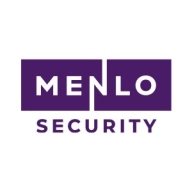

Portnox and Menlo Secure are competitors in the network security space. Menlo Secure has a competitive edge due to its advanced security features.
Features: Portnox specializes in network access control with robust device management and compliance monitoring. Menlo Secure excels in web isolation, providing superior threat protection and ensuring secure browsing experiences. Portnox emphasizes internal network controls, while Menlo Secure is focused on mitigating web-based threats.
Room for Improvement: Portnox could improve its capabilities for web-based threat protection and enhance its cloud deployment options. It could also expand on advanced reporting features. Menlo Secure could improve its pricing model to be more competitive, enhance the clarity of its logging features, and expand the number of sites automatically bypassing isolation.
Ease of Deployment and Customer Service: Portnox offers a streamlined on-premise setup with comprehensive customer support, simplifying the implementation process. Menlo Secure provides effective cloud-based deployment with reliable assistance, with a primary focus on cloud solutions and robust customer service.
Pricing and ROI: Portnox offers a competitive pricing model with strong ROI for organizations requiring extensive network management features. Its cost advantage is notable compared to Menlo Secure, which, despite higher initial costs, provides ROI through advanced security offerings, particularly beneficial for web threat protection.


Menlo Security Secure Application Access
Menlo Security Secure Application Access makes zero trust access easy, giving users secure connectivity to private applications, including web and legacy applications. At the core of Secure Application Access is the Menlo Secure Cloud Browser, which fetches, secures and delivers the content for users.
In addition to providing simple-to-deploy, clientless ZTA, Secure Application Access and the Menlo Secure Cloud Browser protect applications from attacks such as session hijacking, cookie manipulation, and other tactics that employ protocol manipulation.
Secure Application Access protects applications from Internet threats and provides granular controls for added protection of the application and associated data. These security controls include Read-only/Read-write, Upload/download, Copy/paste, AV scanning, Sandboxing, and Data Loss Prevention.
Last Mile Data Protection
Menlo Last-Mile Data Protection identifies and prevents sensitive data from leaving your company by meticulously inspecting all file uploads and user input across browsing sessions. Leveraging the Secure Cloud Browser, users are protected from the internet and you can protect your organization from data loss with comprehensive traffic monitoring and controls. This approach addresses the growing concerns surrounding data leakage in the age of AI tools like ChatGPT.
By identifying sensitive data through file types, regular expressions, or predefined libraries, Menlo Last-Mile Data Protection empowers security teams to regulate data input into AI platforms and prevent unauthorized uploads. This capability provides crucial protection for intellectual property, PII, and other confidential information.
The solution leverages the Menlo Cloud Security Platform's visibility and control over traffic to reliably detect and prevent data leaks originating from both browser submission forms and non-browser traffic. With the ability to inspect encrypted web traffic, Menlo Last-Mile Data Protection enforces DLP policies consistently across all users and devices, ensuring comprehensive data protection.
Portnox offers Network Access Control to manage user access based on policy, securing both wired and wireless networks while ensuring compliance. It supports endpoint security and prevents unauthorized access across industries such as banking, IT, and energy distribution.
Designed for both on-premises and cloud deployments through CORE and Clear versions, Portnox delivers a straightforward interface aiding in deployment. It integrates effectively with equipment from multiple vendors and security solutions, enhancing endpoint profiling and ensuring compliance. Portnox provides real-time alerts and network activity insights, bolstered by excellent technical support and scalability. It also automates monitoring, reducing the need for dedicated resources while offering a comprehensive view of network activities.
What are the essential features of Portnox?
What benefits should users focus on in Portnox reviews?
Across industries like banking and IT, organizations rely on Portnox for endpoint profiling and compliance, ensuring remote worker security. Electricity distributors leverage its robust features for managing secure network access. Improvements like better third-party integration, enhanced graphical interface, and expanded support are desired, along with licensing adjustment and expanded use of AI and behavioral analytics.
We monitor all ZTNA reviews to prevent fraudulent reviews and keep review quality high. We do not post reviews by company employees or direct competitors. We validate each review for authenticity via cross-reference with LinkedIn, and personal follow-up with the reviewer when necessary.